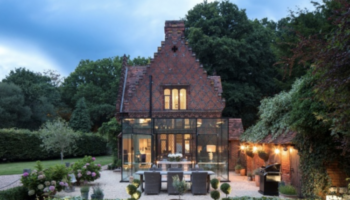

In the current climate there’s no doubt that it’s cheaper to improve than to move. Adding another room is usually the most reliable way of adding value to a property so if you can combine the selling power of a fabulous new kitchen in a new, and/or larger, space then you should be onto a winner.
But you need to know the ins and outs – or ups and downs as it were – of creating that space. Do you want to go into the loft, the most obvious solution? Or into the side return – a good use of dead space – with a modern glass extension. Or, the most expensive and the latest option – into the basement. It doesn’t even matter if you don’t have a cellar. If you can write a big enough cheque you can have one dug.
There is a house in Kensington whose owners have gone down 100ft to a bore hole which taps into the water table giving them their own water supply. They have also installed a biomass generator in the sub-basement which runs off wood chippings and other biological waste and they sell the energy it generates back to the National Grid. You can’t necessarily factor this into your mortgage calculations but it seems to have worked for them.
Building up



The most obvious solution is to go into the loft space, although some houses convert better than others. You will get an extra bedroom and a bathroom into a narrow Victorian terrace but it will have a sloping ceiling and the room will be small. In a 1930s square house, you will do much better. Ian Garner, manager of Absolute Lofts says: “Loft conversions are the cheapest way to extend and the best way to give parents a space of their own or get rid of a sulky teenager.
“The problem with an extension downstairs is that you might have to pay £30,000 for the building and another £20,000 for the kitchen to put in it. A basic loft conversion should start at about £35,000 with the cost of a bathroom and that’s it.”
The rules on loft conversions are changing all the time. As of 18 months ago you probably don’t need planning permission (check with Planningportal.co.uk) but new building regulations means that all doors that access the stairs – in the entire house – must be fire doors. If, and many people do, you later remove them and neglect to inform a new owner in writing, you could be held responsible for any accidents in a fire. Having said that you can now buy oak panelled fire doors. “Fire doors are much more attractive than they used to be,” says Garner. “Although they cost about £150 so you need to factor that into your budget.”
There is a company, Envirograf that will paint your original Victorian doors in a fire resistant varnish but it’s not a money saving option.
If you are thinking of converting your loft and can’t imagine how much space you will gain, picture your ground floor footprint with about one third taken off at the front, which you can use for storage.
Digging down


The newest, and most costly, solution, particularly for space-starved and cash-rich dwellers. Dig down and create a media room, an extra sitting room or, even a swimming pool. Basements are not just for the super rich these days although there is a certain amount of resistance to the idea of living underground. On the upside, if you live in a conservation area, the council are more likely to grant planning permission to go down than for a loft.
David Hilton, of Abtech Conversions says: “Basement extensions are now widespread and there is no basement that can’t be dug out if you can afford to pay for it.
“People are creating playrooms, extra bedrooms, a bath and a utility room for about £100,000 with everything fitted out. You basically get the size of your downstairs again – unless you also go out under the garden.”
As a rough estimate of price, you can expect to pay from £800 a square metre if you have an existing cellar that needs deepening, £1,400 if you don’t have a basement at all and £200 if you have a full height cellar that needs tanking and fitting out.
“Don’t forget you will also need to pay a builder for the plumbing and electric work as well as plastering and installation of whatever you are putting down there,” says Hilton. He also advises that you seek the opinion of an independent architect before you start.
As for the neighbours, a recent survey in Kensington and Chelsea found that digging out basements had no detrimental effects on the house next door, although you will need to seek a party wall agreement. And if your house is subsiding, digging out a basement can be a good idea as you will be underpinning and strengthening the foundations at the same time.
Finally, the big question – will it add value? Hilton says: “If you live in an area of medium to high value then the answer is yes. You will get your money back at resale. If you don’t then the cost of doing it is probably prohibitive and it’s not worth doing – in other words no to Ilford, yes to Guildford.”
Pushing out
Most classic Victorian houses have a side return – a long narrow passage of varying dinginess, which is usually only wide enough for the bin and a couple of bikes. It is neither attractive nor particularly useful so if you can push your kitchen out in that direction, then it’s worth considering.
“Glass is the new brick,” says Mark Bonnington, of Glass Design and Build, based in London and Yorkshire “The technology is moving forward all the time and the structural glazing that was previously only used for commercial builds can now be done on a domestic scale.”

It’s still not a cheap option, but the cost is coming down. You should budget at least £45,000 for a basic side return with extra for the electrics, plumbing and fitting out.
The good news is that you probably won’t need planning permission. Before 2008, you could extend by 10 per cent of the original size of your property, but as planning departments became increasingly swamped, the rules were changed. Now you can go out by three metres, any width along the back of your house and up to four metres high without permission – although you will need to check that if you live in a conservation area.



“I have been in the building trade for 20 years and we are seeing the disappearance of the traditional brick extension with windows, which moved on to the UPVC conservatory – that we call blisters – to these modern frameless glass extensions,” says Bonnington. “There’s no doubt that they add value to the house and can even sell it for you, not to mention the enjoyment you get from the extra living space.”
For the practically minded, Bonnington points out that you can hose a glass roof down from an upstairs window, or powerwash it from below. “You can have coatings applied to keep it clean, as well as solar coatings that will help regulate the temperature. An extension like this really adds the wow factor.”
first published in The Independent




